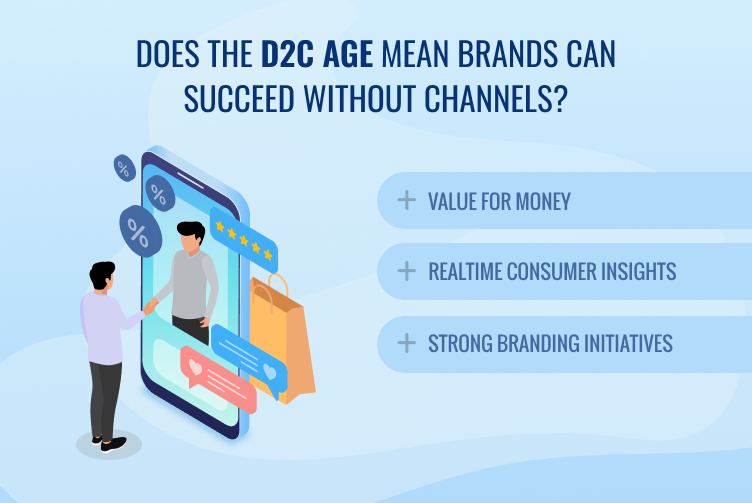With the constant surge in eCommerce, it is becoming more prudent to add direct-to-consumer (D2C) capabilities to stay ahead. Over the last decade, eCommerce has grown exponentially, which confirms its role as one of the critical assets for businesses adapting to the digital world. The pandemic only amplified this. D2C capabilities are prepared to leverage this trend while also tapping into the physical store space.
As per Statista, by 2025, the Indian D2C market of fashion and accessories is expected to be worth $43.2 billion. Likewise, the consumer electronics market size will be around $30.6 billion, while FMCG and home decor will be worth $20.8 billion and $5.4 billion, respectively.
What is the D2C Outbreak?
The D2C sales model is based on the sale of the manufacturer’s products to end users directly, without intermediaries. This gives brands the leverage to sell products at a relatively lower cost than conventional consumer brands while maintaining end-to-end control over the vital aspects of sales – manufacturing, marketing, and product distribution.
Unlike traditional retail, D2C brands have the freedom to experiment with multiple distribution models. They do not depend on regular retail stores for sales. D2C startups are well-positioned to compete with leading retail brands.
In fact, D2C presents a great opportunity for brands to develop direct customer relationships. Brands can interact with their end-users and steer innovation and brand strategy based on real-time insights. These insights are extremely helpful in answering consumer needs, thus maximising brand commitment and lifetime value.
Leaders in the market consider D2C to be the primary growth factor. However, that does not mean the channel strategy can be replaced. Brands cannot succeed and sustain themselves without a robust channel strategy. A channel is essential to reach those geographically dispersed areas with potential consumers. Although brands may capture and capitalise on the D2C channel, a sizeable proportion of their sales comes from indirect, traditional distribution channels.
Why Do Brands Rely on D2C?
The insight, oversight, and power of selling directly provide many incentives.
- Controlled Branding: Firstly, D2C bridges the gap between the brand and its end consumer. This ensures full control over the content as well as communications. Product descriptions and features are on-brand, maintaining one tonality that resonates with the brand value. In fact, D2C is the ideal platform for A/B testing and trying out innovative design and content ideas.
- Direct Consumer Engagement: Brands can develop retention through creative loyalty programs, personalised communications, and email campaigns — boosting sales, building loyalty, and creating brand awareness. They can curate customised online catalogues and build cross-selling as well as upselling opportunities without any distractions. Product bundles, offers, promotions, discounts, and subscriptions are some of the best ways that lead to more sales.
- Better Understanding Of Consumers: When brands deal with consumers directly, it allows them to collect data about consumer behaviour. This empowers them to personalise their messages and create innovative D2C campaigns, thus making way for effective conversion. They are also empowered to build their target audience and leverage granular geographic information for ad placements.
So, Can Brands Succeed Without Channels?
Understandably, brands acknowledge that D2C is a moat channel they should empower for organic growth, greater control over customer experiences, and to cut off the retailer and marketplace bullying. Over the past year, 65% of Indian brands developed their website, which is phenomenal growth. To top that, their websites received 88% growth in order volume.
However, since brands are spending more on advertisements to boost website traffic, D2C is becoming an expensive channel to maintain. Hence, channel sales cannot be written off right now or even in times to come.
Direct Sales vs. Channel Sales
Channel sales involve a third party for selling and distributing the products and services. On the other hand, in direct sales, companies sell their products and services directly to consumers. Companies using channel sales need not engage an in-house team for sales, though they can use a mix of both direct and channel sales for increased revenue.
In channel sales, a certain percentage of the profit is shared with the third party, whereas direct seller keeps the profits to themselves. Large businesses make greater profits through channel sales, but small enterprises thrive with D2C.
Channel Sales – The Winning Strategy
Channel sales represent the traditional sales model, which involves product distribution to the market by segmenting the sales operations. For example, a brand can implement this strategy to sell its product through an in-house team, retailers, dealers, direct marketing, or affiliates. Hence, the scope of business is wider.
As elucidated above, channel sales include third parties offering products or services to consumers. Selling through a robust network of channel partners provides better leverage to the business. Distributors, re-sellers, value-added service providers, and similar channel partners can provide better outreach. Most importantly, it is a cost-effective way of entering the new market as it does not involve the cost of local operations and maintenance.
Besides, channels nurture predictability and financial stability, which translates to a better long-term strategy for businesses – especially those operating in very niche segments. Their sales engine is bolstered by the effective distribution of products and services to their target audience while they enjoy a better cash flow, are better equipped to predict future market conditions, and can plan for resources and expenses more effectively.
The Bottom Line
D2C business models are surely lucrative options for brands. However, traditional distribution channels bring to the fore a proven strategy that is not on the verge of extinction anytime soon. In the current landscape, channel strategy is ideal for growing and sustaining the business.




